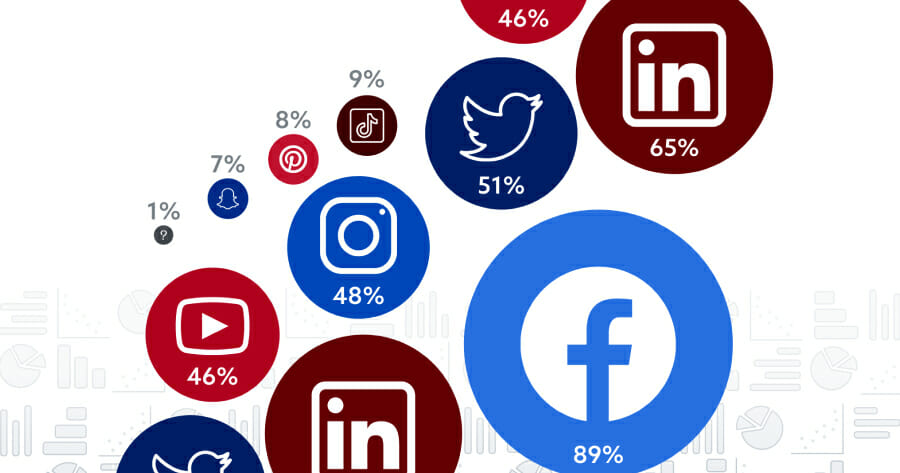We’re in the social age.
Everyone’s friending, following, engaging, liking, and subscribing to everything online. It’s the time of mass connectivity – and mass noise. This noise can be challenging for financial brands like yours, that are looking for ways to connect with your target customers.
But when you delve into the data analytics of how consumers engage with financial brands online, there are trends you can find. From the results of our 2021 Marketing and Compliance survey, which was distributed to a mix of banks and credit unions, we found that 89% of participants are represented on Facebook, followed by LinkedIn (65%), Twitter (51%), and Instagram (48%). Knowing how to navigate the complexities of each social channel in your marketing mix is one of the biggest challenges that financial marketers face.
Here’s some guidance on how to share the love on all of your social media accounts!
With over 2.7 billion monthly users, it is no wonder that Facebook is the channel of choice for banks and credit unions. This popular platform continues to evolve as a business tool. With targeted advertising options, the ability to invite users to your page, and quick customer service interactions, Facebook is the spot for brands and customers to interact. This is the platform that your financial brand should be sharing general news, photos, and business updates. We recommend posting 3-4 times per week to remain active and engaging. Fans of your business come to your page to find out what’s going on with your company or explore upcoming events.
Tool to Use:
Paid advertising. Creating an ad on Facebook is a smooth process. You’re able to choose the kind of ad, your targeted audience, your timeframe, and your budget. Because it is so customizable, you can create a paid advertisement that reflects your brand.
Twitter is fast-paced and concise, generating nearly 175 million tweets daily. This platform allows you to share quick, timely information. Maybe you’re attending a conference and you want to share a short blurb about your experience. Twitter is the place where followers want to engage in conversation. Whether it’s about trending topics, news, or customer support, don’t be afraid to use your voice on this platform!
Tool to Use:
Hashtags – use them consistently! These allow you to get involved in existing conversations as well as start new ones. These show that your content is relevant to a certain topic and helps increase your visibility on the platform.
LinkedIn is primarily used for B2B (Business to Business) marketing, recruitment, social selling, thought leadership, and employer branding. Financial brands find the best use cases for content on LinkedIn when users are consuming images, videos, native blogs, and infographics related to their brand and area of expertise.
Nurture your relationships on LinkedIn by engaging in discussions, answering questions, and commenting on relevant content in your newsfeed. Show your customers that you are up to date on trends and want to provide them with advice and information about the financial industry.
Tool to Use:
LinkedIn Events. These serve as a networking tool and learning hub. Use this tool to share your upcoming webinar or new branch opening! There is an option for the public to join or for attendees to accept an invitation. This is a great way to involve connections and share information about the financial services industry.
Is Instagram right for financial brands? The answer is yes.
Customers expect your brand to be on Instagram. Don’t fall in the trap of thinking that financial brands have nothing visually interesting to post. Your financial brand has the power to demonstrate brand culture and storytelling through this platform. Share pictures of in-branch initiatives or community events! You could also highlight an employee of yours each week, sharing their story, and the impact they’ve had on your brand. Showcasing a variety of images and videos is a great way to capture your younger audience. Having an Instagram account shows that your financial brand is real, trustworthy, and transparent.
Tool to Use:
Link in Bio. It is common to refer to your “link in bio” when posting on Instagram. Let the link in your bio serve as a landing page with a mix of recent content and links back to your most important service pages. Be sure to change this every so often and keep it up to date.
TikTok and Snapchat
There are still many questions on what kind of return banks and credit unions could see from having a digital presence on channels like TikTok and Snapchat. From what we are observing, these channels are primarily used to reach a younger demographic and are great for video content to educate on brand products and services, share customer or employee testimonials, and for community impact events (Snapchat filters!). With engagement driven by short-form video content, these platforms see high engagement and loyalty rates, keeping users entertained and engaged with consuming platform content.
Consumers habitually log onto social media daily and are exposed to different content and companies each time. Your financial brand should be one of these companies. Reshape your social media marketing by posting a good mix of content on each channel!
If you’re wondering how you can manage all of these platforms at one time, check out our marketing solutions on our website! We offer a Social Media Platform made for financial brands.


